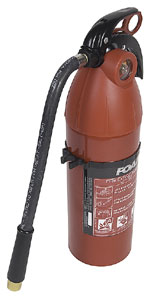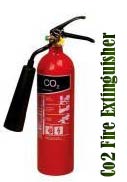|
|
 |
Home / Fire Extinguishers
|
|
 |
|
|
|
|
|
|
|
How Does A Fire Extinguisher Work? Modern extinguishers
contain an inner cartridge filled with carbon dioxide, which is the chemical that
creates the pressure over the extinguishing agent. Once you push a lever, the carbon
dioxide will push the agent and project it through the hose. The pressure will permit
the user to point the fire from a safe distance, permitting him to maneuver and
control the fire. |
|
Categories of Fire Extinguishers There are several
types of fire extinguishers. They have been specially designed for determined types
of burning material. Why? As we have gained more experience on this theme, we have
learned that some extinguishing agents are better than others when you use them
on wood, liquids or electrical equipment:
|
Class A(Geometric Symbol:Green Triangle) extinguishers
are for ordinary combustible materials such as paper, wood, cardboard, and most
plastics. The numerical rating on these types of extinguishers indicates the amount
of water it holds and the amount of fire it can extinguish.
Class B(Geometric Symbol:Red Square) fires involve
flammable or combustible liquids such as gasoline, kerosene, grease and oil. The
numerical rating for class B extinguishers indicates the approximate number of square
feet of fire it can extinguish.
Class C(Geometric Symbol:Blue Circle) fires involve
electrical equipment, such as appliances, wiring, circuit breakers and outlets.
Never use water to extinguish class C fires - the risk of electrical shock is far
too great!Class C extinguishers do not have a numerical rating. The C classification
means the extinguishing agent is non-conductive.
Class D(Geometric Symbol:Yellow Decagon (Star)) fire
extinguishers are commonly found in a chemical laboratory. They are for fires that
involve combustible metals, such as magnesium, titanium, potassium and sodium. These
types of extinguishers also have no numerical rating, nor are they given a multi-purpose
rating - they are designed for class D fires only.
Class K(Geometric Symbol:Black Hexagon) Although it’s
also used for oils, this extinguisher was specially created for commercial kitchens.
It’s a rare kind of extinguisher since it only has eight years in the market. Most
restaurants still use the Class B extinguisher.
|
 |
|
Carbon Dioxide (CO2) extinguishers are used for class
B and C fires. CO2 extinguishers contain carbon dioxide, a non-flammable gas, and
are highly pressurized. The pressure is so great that it is not uncommon for bits
of dry ice to shoot out the nozzle. They don't work very well on class A fires because
they may not be able to displace enough oxygen to put the fire out, causing it to
re-ignite.
|
 |
|
How to Choose a Fire Extinguisher? If you want a fire
extinguisher for your home, then you should choose an appropriate one. If it is
for your kitchen, then you need to go for a Class K extinguisher. In case you need
another one for wood and cloth, then you should go for a Class A extinguisher. Read
the labels carefully before buying. |
|
How to Use a Fire Extinguisher? Using a fire extinguisher
isn’t as simple as point and shoot. Although it is your only option in case of an
emergency, it is better to have some basic knowledge. First of all, read the instructions.
You may find one or two surprises. And second, call your local fire brigade and
ask about basic training for fire suppression. |
How to Maintain the Fire Extinguisher? Fortunately,
fire extinguishers now come with a determined shelf life. If your fire extinguisher
lifetime is ending, then you should consider buying a new one or refilling it. You
can also make a regular fire extinguisher inspection to check if the extinguisher
is still working. Rechargeable fire extinguishers are also available, but it should
be done by an authorized provider.
Fires can be voracious animals. Since we are not accustomed, we may not consider
them a high risk for our house. But it’s better to eliminate the probability of
suffering a fatality due to fire. Place fire extinguisher signs and buy one or two
portable fire extinguishers. Maybe, someday, they will save your life. |
|
|
|
|
|
|
|
|
|
|
|
|
|
|
|
|